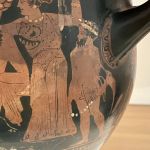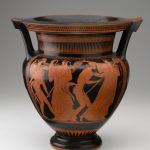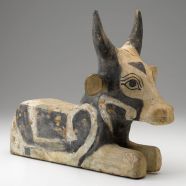
Egyptian, said to be from North Saqqara, Reclining Bull, 305–30 BCE, wood with gesso and paint, 14 1/2 × 11 × 18 1/4 in., North Carolina Museum of Art. Gift of Mr. and Mrs. Gordon Hanes.
Share This
Print This
Email This
Dogs or Gods: The Roles of Animals in Ancient Egypt and Greece
Having lived in China, the United States, and Scotland, I, as a dog owner for most of my life, notice the universal love people have for their animal companions. Now that I am studying ancient civilizations, interactions between humans and animals in ancient Egypt and Greece have become a fascinating topic to me. Indeed, visual representations of animals are ubiquitous in both cultures. Yet, their attitude toward animals was completely different: the idea of animals being the embodiment of deities and divine powers was central to the ancient Egyptian religion but religious associations of animals were restricted to mythical creatures and animal sacrifice for the Greeks. Several antiquities from the ancient Egyptian as well as ancient Greek, Italian, and Roman collections at the North Carolina Museum of Art (NCMA) help illustrate some of their differences.
Ancient Egyptians comprehended their relationship with a vast range of animal species through their religious system. Their religion explained human’s relation with everything and every event around them, including the landscape, death, social structures, and so forth. In this worldview based on religion, animals were prevalent everywhere: deities could appear in a zoomorphic (animal), anthropomorphic (human), or hybrid form (animal head with human body). The last type was a unique feature in Egyptian religion not found in Greece (with certain exceptions). Most of the Egyptian deities discussed below, such as Sekhmet and Anubis, were commonly represented in their composite body. Such religious figures blending animal and human form were possible because the two beings were considered relatively equal. The standard of morality was for people to treat humans and animals with sympathy and respect: it was equally important for one to provide food, water, and shelter to both people and animals in need. At the time of creation, humans and animals were regarded on the same level—humans were not born superior to animals nor were they the lord of them; rather, humans were partners and cohabitants with the animals. The creative and living force of the deities existed in all lives, including animals, like cattle, reptiles, and humans (see, for example, the Memphite Theology on the Shabaka Stone). It is, nevertheless, important to emphasize that it was not animals that the ancient Egyptians were worshiping, a misconception of not only modern readers but also ancient travelers. Instead, the animals were merely an intermediary between humans and the divine.
Not far on the other side of the Mediterranean, animals also played an important role in the everyday life of the Greeks. They tended sheep and goats for milk and cheese, and cattle for meat. They raised dogs for hunting, guarding, and entertainment and used horses for cavalry and chariots. However, even though they associated deities and mythical creatures with animal elements (e.g., Poseidon and dolphins, Artemis and deer, Dionysus and panthers), it was uncommon for the gods themselves to be represented in animal forms. Instead, composite creatures were more likely to be minor regional deities (with the exception of Pan) and mythical creatures or belonged to the world of monsters.
Generally, composite creatures were not worshiped as gods but rather believed to be mythical beings, like centaurs, the horse-bodied savage men living in the mountains of northern Greece. Satyrs were another group of semi-anthropomorphic creatures, appearing as males with a horse tail and ears, a round and upturned nose, and tiny horns on their head. They were companions of Dionysus and enjoyed drinking, dancing, flute-playing, and sexual pleasure. Their companionship with Dionysus can be seen, for example, on the Bell Krater at the NCMA (fig. 1). Satyrs are also frequently portrayed sexually harassing nymphs, as they are seen on the NCMA’s column krater (fig. 2). On one side, two balding and naked satyrs pursue two nymphs who playfully avoid the attack. Two other satyrs disturb the nymph fetching water from the fountain. The vase wholly presents the lecherous and savage animal-bodied creature in a sensual and flirtatious environment.
- Fig. 1: Detail of a satyr, Meleager painter, Greek, Bell Krater, first third of the fourth century BCE, red-figure ceramic, 15 1/2 × 15 3/4 in., North Carolina Museum of Art. Gift of Dr. and Mrs. Fred Olsen.
- Fig. 2: Fountain house scene, Syriskos painter, Greek, from Attica, Attic Red-Figured Column Krater, circa 470 BCE, red-figure ceramic, 17 × 16 3/4 in., North Carolina Museum of Art. Purchased with funds from the Friends of Greek Art, and gift of Walter Banko.
Another category of creatures in animal-human bodies is monsters who were ill-omened and whose existences were unlawful. The famous Minotaur, for example, is portrayed to be a bull-headed man due to his wrongful birth. This association between hybridism and monstrosity may stem from the Greeks’ tendency to make a clear distinction between man and animal. Unlike the Egyptians, the Greeks believed that animals had no justice or piety, qualities exclusive to men. Therefore, when Odysseus’s companions are turned into pigs by Circe, they suffer the agony of retaining their human awareness within their dumb, acorn-eating bodies (Od. 10.133–399). Creatures in hybrid forms ultimately lost their ability of human communication, physicality and power and were thus deemed unlawful and savage.
Regardless of their bodies, Egyptians treated their gods with reverence. For example, lionesses were viewed as the avatar of the Egyptian goddess, Sekhmet. Most often, she appears with a lioness head on a human body, as shown in a bust of Sekhmet at the NCMA (fig. 3). The association between Sekhmet and the lioness perhaps originated from the dual characteristics of female lions: they exhibit terrifying aggression as a predator, and yet as a mother of their cubs, they are a nurturing protector. Indeed, Sekhmet herself was the goddess not only of war, destruction, and plague but also of healing, protection, and kingship. Her apotropaic power can also be manifested onto large cats who were occasionally kept as pets by pharaohs in order to channel their divine connection.
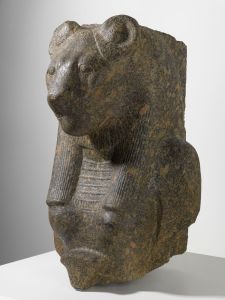
Fig. 3: Egyptian, Bust of the Goddess Sekhmet, circa 1390–1352 BCE., granite, 23 × 15 1/2 x 14 in., North Carolina Museum of Art. Gift of Mr. and Mrs. Gordon Hanes.
However, in Egyptian religions, the animal representations of deities often overlap, and hence many other goddesses, such as Bastet, Mut, Hathor, and Tefnut, may also be represented as a feline. Bastet, in particular, was represented either as a cat or a cat-headed woman carrying a basket. The cat’s sacred association with the goddess consequently brought them many special treatments. Cats were protected and attentively cared for: many of them were specially raised in the temples and occasionally dressed and applied ointment to by priests. Cats could be also bribed with milk-soaked bread and pieces of fish. Herodotus records that, when there was a fire, the Egyptians paid more attention to protecting the cats from jumping into flames than noticing the blazing fire and the destroyed properties (Herodotus 2.66). After Egypt became part of the Roman Empire, Diodorus tells a story about a Roman man who accidently killed a cat and was in turn murdered by a crowd of angry Egyptians despite official intervention (Diod. Sic. 1.83.8–9).
Nevertheless, after a short and pampered life, many cats were killed at a young age for mummification, a practice prevalent from the Third Intermediate Period to the Ptolemaic Period (1069 BCE–30 BCE). Although the NCMA does not have animal mummies, millions of them were recovered in the two animal catacombs in North Saqqara and Tuna el Gebel, Egypt. The demand for cats was so high that priests occasionally opted for a cheaper option containing only part of the animal while the exterior resembled a complete animal mummy. Although deliberately breeding and murdering a young animal might sound cruel to many modern readers, it is important for us to interpret this religious practice from the perspective of pious ancient Egyptians: the raising and killing of these animals should not be simply understood as a destruction of lives but rather an opportunity for the animals and their souls to arise from death. It was the death of these sacrificial animals and the following rituals that brought them their religious significance and attention. Ironically, when these sacred animals were first excavated in the nineteenth century, some of them were exported to Britain and elsewhere in Europe to be used as fertilizer because they were deemed less valuable than the dazzling wealth found in lavishly equipped tombs.
Large cats were also admired by ancient Greek artists and workshops but without any religious connotation. The lion in the Etrusco-Corinthian pottery at the NCMA (fig. 4), for example, does not represent any divine power. Rather, its ecological position as a powerful and undefeatable predator is what matters here. The ancient Greek authors of natural history saw the lion as a symbol of strength, fierceness, and domination. This association already existed in the Bronze Age: when lions were used as an iconography, their presence was often closely connected with royal and military power. Homer was also well aware of this tradition: when a warrior is compared to a lion in The Iliad, he almost always obtains victory.
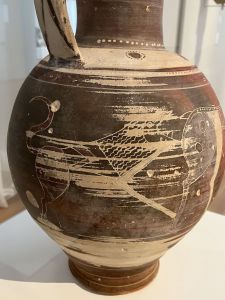
Fig. 4: Detail of the lion on the NCMA’s Neck-Amphora, Etrusco-Corinthian, early sixth century BCE, ceramics, 19 1/2 × 11 7/8 in., North Carolina Museum of Art. Gift of Mr. and Mrs. Gordon Hanes.
Interestingly, it is very likely that the original Greek creators of these lively portrayals of lions had never actually seen a lion in real life! The presence of lions in ancient Greece is still debated to this day. Even though ancient writers such as Herodotus and Aristotle attest their existence in northern Greece, archaeological evidence is too rare for modern-day scholars to settle on a definitive answer. In fact, scholars have long been speculating that the iconography of lions was borrowed from the Near East during trading.
Compared to ancient Egyptians, the Greeks had much less interest in domestic cats. Brought from Egypt, cats did not become popular until the second century CE. On the other hand, dogs were loved by the Greeks because of their faithful companionship and safeguarding ability. Greek and Roman epitaphs reveal that many pet owners wept and mourned for the passing of their beloved dogs; archaeological evidence also shows that many dogs received their own burial or were buried with their owners.
Artistic representations of dogs are omnipresent on Greek tombstones and vases. Athenian women and children are commonly accompanied by small and cuddly Maltese dogs on their tombstones. Young Athenian men, however, are more likely to be seen with a hunting dog that resembles a greyhound. These hunting dogs were their constant companions for hunting, socializing, and entertainment. For Athenian men, dogs were also important in their homoerotic life—dogs could be given as a love gift from the erastēs (the older male lover) to eromenos (the younger male receiver of the affection) and thus represent the erotic connection between the partners.
The Hadra hydria at the NCMA (fig. 5) is an example of the popularity of canines on Greek vases. Funerary vessels of this type were typically found in the Hadra necropolis in Alexandria, Egypt, but they are argued to be produced and exported from the island of Crete. This burial area in the Nile Delta was reserved for the Greek religious envoys and merchants who settled in Egypt during the mid-third to early second century BCE, during which many of the immigrants retained their Greek heritage and culture. Therefore, the iconography is typical of Greek art. In figure 5, a dog is shown leaning on its front legs, confronting and barking at an ibex, a type of wild goat. Though some might argue that the scene is not finely painted, it is undoubted that the interaction between the two animals is quite lively and amusing.
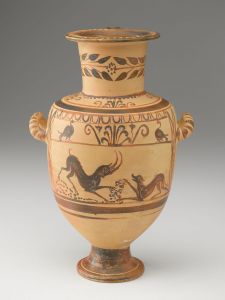
Fig. 5: Animal figures on Hydria, fuzzy painter, Greek, probably from Hadra, Egypt, Hydria, late third century B.C.E., ceramics, 15 1/2 × 7 1/2 in., North Carolina Museum of Art. Gift of Mr. and Mrs. Gordon Hanes.
As much as the ancient Greeks adored their faithful and courageous companion, a mixture of emotions such as avoidance, mistrust, and fear were also associated with dogs. It is true that some dogs were domestically trained, but others were simply brought into the house and thus still exhibited the characteristics of wolves and jackals. Since dogs also possess nonverbal communications, which pose a barrier between them and their humans, the Greeks were aware that their once trusted canine friends could easily tear them apart or turn into a scavenger, feeding on their corpses.
Canines’ habit of consuming carrion was also carefully noted by the ancient Egyptians, but they took this observation to a religious level—the dog family was chosen to be the avatar for a number of Egyptian funerary deities. Anubis, for example, was represented by a generalized form of the jackal and African gold wolf. Attending deeds related to death and kingship, Anubis can be seen either in a zoomorphic form of a long-muzzled canine or in a hybrid form of a canine-headed human occasionally with a tail, but he is rarely depicted in full human form. The NCMA houses an example of Anubis in his zoomorphic form, lying with his front legs extended in front of him and his tail hanging down behind (fig. 6). By being attached to the lid of a box or a coffin, zoomorphic Anubis was trusted to guard Egyptians’ secrets and valuables presumably because they had seen jackals burying and hiding their food.
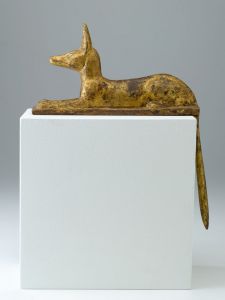
Fig. 6: Egyptian, Anubis in the Form of a Reclining Jackal, 715–525 BCE, wood with gesso and gilding, 6 1/4 ×2 5/8 × 12 in., North Carolina Museum of Art. Gift of Mr. and Mrs. Gordon Hanes.
Ancient Egyptians were also very affectionate toward domesticated dogs; some of their love even transcended life and death. An Egyptian man named Ku wished to have a peaceful afterlife with his dog, Meniu-pw, and thus chose to have an image of him walking his dog on a leash on his coffin (DE11568 at Egyptian Museum, Cairo). Another Egyptian man named Hapimen mummified his dog and went into the underworld with his canine friend curled at his feet (E16220A-B, E16219 in the University of Pennsylvania Museum of Archaeology and Anthropology, Philadelphia).
Truly, many animals were revered because of their divine connections in ancient Egypt, but their religious powers were ultimately achieved through sacrifice and mummification. Certain animals were worshiped without being killed because they themselves were considered to be the reincarnation of a deity, housing the divine soul. The cult of Apis bull is a famous example. Apis bull was traditionally considered the embodiment of the creator god, Ptah, and later also associated with a Greco-Egyptian deity, Sarapis. Unlike sacrificial animals, Apis bull was a singular bull specifically chosen based on a set of criteria. The Apis bull at the NCMA could provide some clue to the special markings: it is black and white throughout its body, but its face is painted white with an inverted black triangle on its forehead (fig. 7).
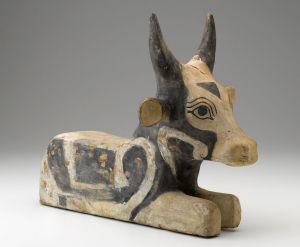
Fig. 7: Egyptian, said to be from North Saqqara, Reclining Bull, 305–30 BCE, wood with gesso and paint, 14 1/2 × 11 × 18 1/4 in., North Carolina Museum of Art. Gift of Mr. and Mrs. Gordon Hanes.
Apis bull, once chosen, lived a full and pampered life. It was under the care of priests at the temple and visited by pilgrims. Indeed, its accessibility to the public may have contributed to the popularity of its cult. Unlike the temples in Greece where a cult statue of the worshiped deity was housed and viewed by visitors, cult statues in Egypt were only accessible to the public when they left the temple during certain festivals. Sacred animals, on the other hand, could be seen and even interacted with: Apis bull in Memphis could be visited in his courtyard, and crocodiles of the Fayum god Petesouchos could be fed by the visitors. To have the ability of physically connecting with an animal that was considered the reincarnation of a deity must have strengthened the personal connection between the worshiper and the divinity.
When the Apis bull died naturally, priests and the people living in the area mourned it for seventy days during which they wore mourning clothing, did not cut or wash their hair, lived on a restricted diet of bread and vegetables, and cried loudly for their passing god. The corpse of the bull was carefully and lavishly prepared for an afterlife: it was mummified with the highest treatment, given a grand catacomb, and provided with luxurious grave goods such as gold masks and gilded amulets. After the funeral, another similarly marked bull would be chosen for Ptah who would transfer his soul to a new body.
In Greek religion, bulls also played an important role not as avatars but as one of the most commonly mentioned and expensive sacrificial animals. Thysia, or sacrifice through burning, was an essential ritualized religious practice for the Greeks and was performed by mortals to communicate with the gods, usually asking for a favor or a question. A specific animal or a group of animals were chosen based on sex, age, and color depending on the demands of the deities. After the animal offering was purified, killed, and cooked, gods were able to consume this fatty offering through the smoke that the burning of his portion of meat produced. If a deity was content with their meat and sacrifice, the favor or an answer would most likely be granted to the sacrificer(s).
To be able to sacrifice an expensive animal like a bull would be in the dedicator’s favor, but not everyone had the financial ability to afford such an expense. This led to the countless dedications of animal figurines throughout Greek sanctuaries as a replacement or commemoration of an actual sacrifice. The bull figurine at the NCMA might have also carried this function as a votive offering (fig. 8). As one of the numerous terracotta figurines found in Mycenaean funerary, religious, and domestic space (1400–1200 BCE), the NCMA’s bull depicts the animal in simple geometric shapes, typical to this period, and probably symbolizes an animal sacrifice that intended to invoke fertility.
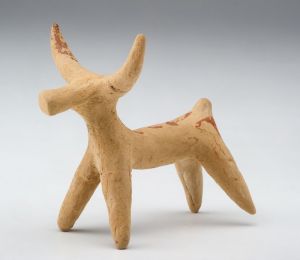
Fig. 8: Greek, Mycenaean, Bull, circa 1400–1200 BCE, terracotta with paint, 4 1/4 in., North Carolina Museum of Art. Gift of Mr. and Mrs. Gordon Hanes.
Notwithstanding that the animal aspects of the Egyptian cult were perplexing to the Greeks, animal cults continued to thrive and reached a popularity greater than ever under the Ptolemaic rule, after Alexander the Great conquered Egypt (305–30 BCE). Alexander himself is said to have performed a sacrificial ritual for the Apis bull. The Greek rulers following him also treated Egyptian animal cults with respect and funding. Greek immigrants were given religious freedom, which allowed them to embrace the local religion.
In this way, during the Ptolemaic Period, two colliding religious systems reached harmony. After all, in both cultures, gods were confidently trusted and personally connected. Humans seek divine help for a variety of issues, regardless of how personal or official these problems might be. Thanks to their common piety and the religious freedom provided by the Greek rulers, the two different religious systems of the Greeks and Egyptians were able to not only coexist but also creatively syncretize, adding new meanings to old deities and producing new deities who are the result of the graceful unity of two cultures, religions, and communities.
References
Al-Ahram Weekly. (2015). “Animals in Ancient Egypt.” SyndiGate Media Inc.
Aston, E. (2014). “Part-Animal Gods.” In The Oxford Handbook of Animals in Classical Thought and Life, ed. G. L. Campbell, 366–83. Oxford: Oxford University Press.
Atsma, A. J. (2000–2017). Satyrs (satyroi). Retrieved 22 April 2022, https://www.theoi.com/Georgikos/Satyroi.html.
Dodson, A. (2005). “Bull Cults.” In Divine Creatures: Animal Mummies in Ancient Egypt, ed. S. Ikram, 72–107. Cairo: American University in Cairo Press.
Ikram, S. (2005). “Divine Creatures: Animal Mummies.” In Divine Creatures, 1–14.
Kitchell, K. F., Jr. (2004). “Man’s Best Friend? The Changing Role of the Dog in Greek Society.” In Man and Animal in Antiquity. Proceedings of the Conference at the Swedish Institute in Rome, September 9–12, 2002, ed. B. S. Frizell, 177–82. Rome: Swedish Institute in Rome.
Kitchell, K. F., Jr. (2014). Animals in the Ancient World from A to Z. New York: Routledge.
Lichtheim, M. (1973). Ancient Egyptian Literature, Volume 1: The Old and Middle Kingdoms. Berkeley: University of California Press.
MacKinnon, M. (2014). “Pets.” In The Oxford Handbook of Animals in Classical Thought and Life, 269–81.
McDonald, A. (2014). Animals in Egypt. In The Oxford Handbook of Animals in Classical Thought and Life, 441–60.
Museum of Cycladic Art. (2016–2022). “Animal Figurine.” Retrieved 22 April 2022, https://cycladic.gr/en/exhibit/aa0072-zoomorfo-idolio.
Reading Museum. (2020). “Sacred Animals of Ancient Egypt.” Collection. Retrieved 22 April 2022, https://www.readingmuseum.org.uk/blog/sacred-animals-ancient-egypt.
Rocheleau, C. (2012). Ancient Egyptian Art: Systematic Catalogue of the Collection, North Carolina Museum of Art, Raleigh. Raleigh: North Carolina Museum of Art.
Steward, A. (2014). Art in the Hellenistic World. Cambridge: Cambridge University Press.
Teeter, E. (2011). Religion and Ritual in Ancient Egypt. Cambridge: Cambridge University Press.
te Velde, H. (1980). “A Few Remarks upon the Religious Significance of Animals in Ancient Egypt.” Numen 27, Fasc. 1, 76–82.
Vandrope, K., and W. Clarysse. (2019). “Cults, Creeds, and Clergy in a Multicultural Context.” In Companion to Greco-Roman and Late Antique Egypt, ed. K. Vandrope, 405–27. New York: John Wiley & Sons.
Wilkinson, R. H. (2003). The Complete Gods and Goddesses of Ancient Egypt. New York: Thames & Hudson.
Zivie, A., and R. Lichtenberg. (2005). “The Cats of the Goddess Bastet.” In Divine Creatures, 106–19.







